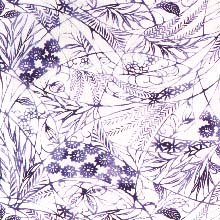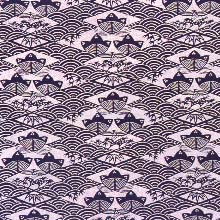Dye (p. 81 )
1. Produced in Katsushikaku, Tokyo.
2. Characteristics: A kind of stencil dyeing, using a "Nagaita"(long plate) to dye indigo cotton fabrics for use for"Yukata,"an informal kimono for summer. "Chugata"(middle size) denotes the size of patterns, ranging between "Daimon"(large pattern) and "Komon"(fine patterns). This dyeing method is traditional from the Edo Period. Also called "Edo Chugata" or "Nagaita Honzome Chugata."
3. Uses: "Yukata".
4. History:"Edo Chugata" is a traditional technique and was widely used for"Yukata" for the common people in the Edo Period. In the end of 1890ユs, however, most cloths for "Yukata"started being dyed with chemical dyes and the need for "Edo Chugata" dwindled gradually. As the trend continued in the Showa Period(1926-1989), a company to preserve "Nagaita Chugata" was established with the cooperation of the government and enterprises. In 1955, both Teikichi Matsubara and Kotaro Shimizu were designated as men of "Important Intangible Cultural Property." The technique has been maintained since then.
Dyeing Method
1. "Jibari"(cloth stretching).
"Himenori"(rice glue) is applied on "Nagaita"(long wooden plate) made of "Momi"(fir, Abies firma) the size of 650 cm long and 45 cm wide. When the glue is dried, the plate is moistened with a watered brush. One half of the total length(1,200 cm) of the rolled cloth is placed on the plate with the remaining cloth in the roll attached to the end of the plate.
2. "Katazuke"(pattern applying)
A stencil paper is put on the cloth and a resistant glue is applied on it with a spatula. The process is also applied on the reverse side of the cloth with special care so that the patterns on both sides are not shifted.
3. "Gojiru Biki"("Gojiru" applying)
"Gojiru" is applied to the cloth and then dried. "Gojiru" is a liquid containing soy-bean which was ground. It is used here for pre-dyeing("Shita Zome".)
4. Dyeing
A tenter, applied at the end of the cloth, is used as a handle to dip the cloth quietly into the indigo vat. The cloth is dried in the air. The work is repeated several times.
5. "Mizumoto"(washing)
The cloth is washed in water to completely remove the resistant glue and then dried.




